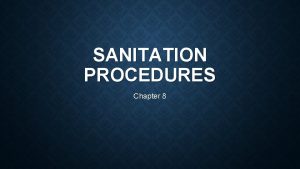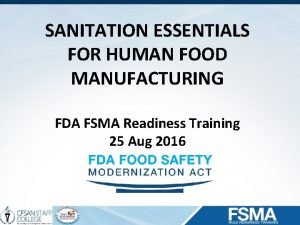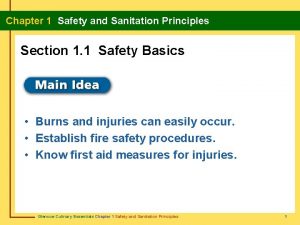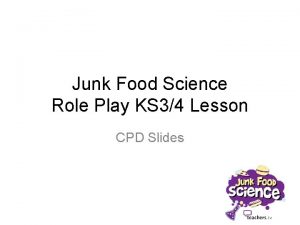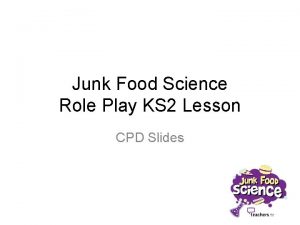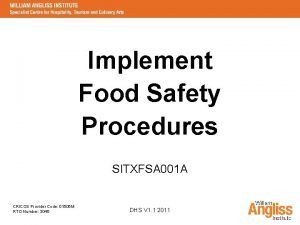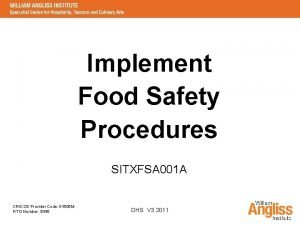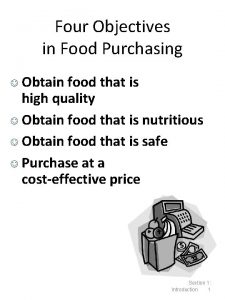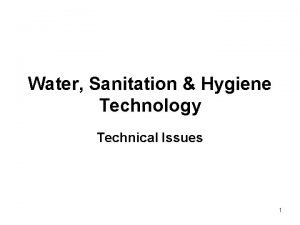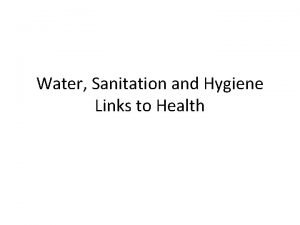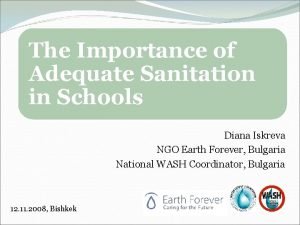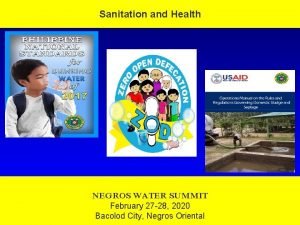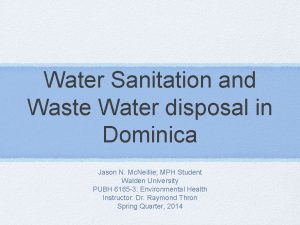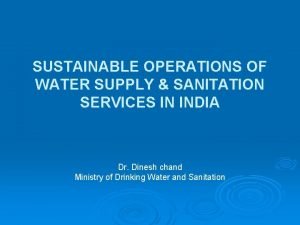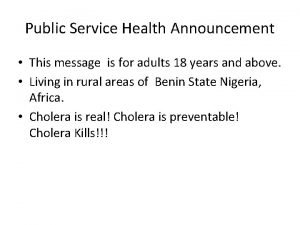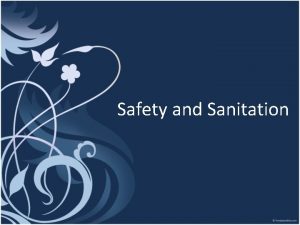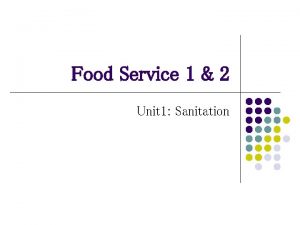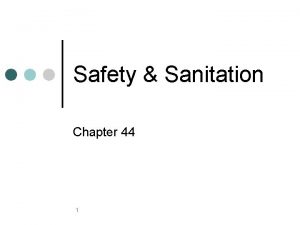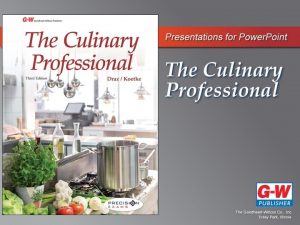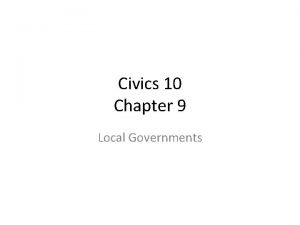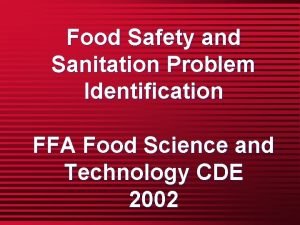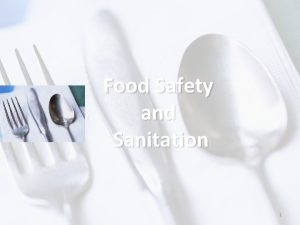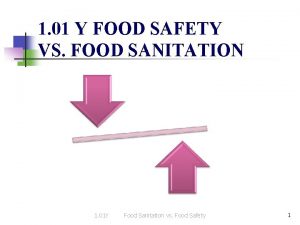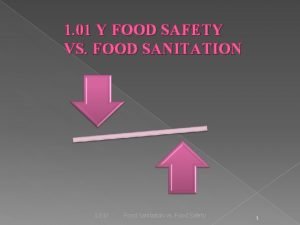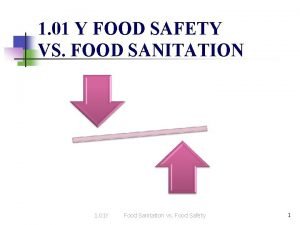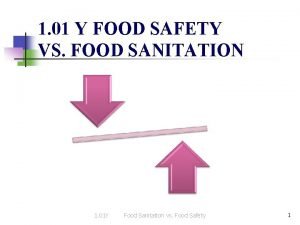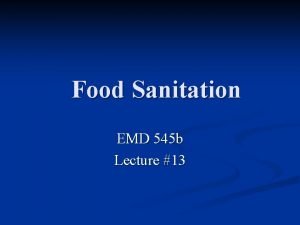SANITATION PROCEDURES Chapter 8 GOVERNMENTS ROLE IN FOOD




















- Slides: 20

SANITATION PROCEDURES Chapter 8

GOVERNMENTS ROLE IN FOOD SAFETY • Food and drug administration • Outlines recommendations for food safety • State and local agencies create their own food safety regulations, but 49 of the 50 states have adopted the FDA food code • United states department of agriculture • Along with the FDA inspect food and create recommendations for food safety regulations • These agencies inspect food and create recommendations for food safety regulations

TIME AND TEMPERATURE CONTROL • Time: food should not be in the food danger zone for longer then 4 hours • Temperature: food needs to be stored above or below 41 degrees F or 145 degrees F • Thawing: • Thaw food in cold running water below 70 degrees, thaw product in the refrigerator, and cook product directly from frozen state • Cooking: • As food cooks it destroys the biological hazards in foods • Most potentially hazardous food is cooked to an internal temperature higher then 145 • The following internal temps need to be: • 165 degrees: poultry, stuffing, and leftovers • 155 hot held eggs and ground meat and fish • 145 for whole muscle meats and fish, raw eggs

• Hot holding • According the FDA food must be held at an internal temperature of at least 135 • Food in a steam table should be stirred evenly and the temperature checked frequently so it doesn’t fall below 135 • Cooling: • Hot fully cooked foods need to be cooled rapidly so it doesn’t spend more than six hours in the danger zone • Cooked foods must be cooled from 135 to 70 degrees in two hours or less and in less then six hours foods must be cooled to 41 degrees • If it isn’t cooled correctly it becomes a breeding ground for biological hazards

• Cooling: • Place food in shallow pans for cooling • Place the container of hot food in ice water bath and stir the ingredients frequently • Place food in a blast chiller or other rapid cooling equipment • Storing • At refrigeration temperatures pathogen growth is slowed greatly • Freezers at 0 degrees stop pathogen growth, freezing kills some biological hazards, but often it just renders them dormant • reheating: • Must be heated to an internal temperature of 165 degrees for at least 15 seconds and it must reach 165 degrees within no more then two hours • Food may only be reheated once!

CROSS CONTAMINATION • Occurs when harmful microorganisms are transferred from one product to another by hands, utensils, equipment or other physical contact • This is the largest sources of foodborne illness • Often negligence or ignorance on the part of the foodservice worker • Can happen in a refrigerator when raw food is stored above another food item and leaks on the food below. • Store all raw meat on the bottom shelf and on a tray, and labeled with date and time stored • If items must be stored together store the item with the lowest minimum internal temperature at the top.

CLEAN VS SANITARY • Clean describes a condition of being free of dirt, grease or grime. • Sanitary refers to an environment that is free from pathogens. • All areas of a professional kitchen must be routinely cleaned and sanitized, any area that comes in contact with food can harbor harmful bacteria.

• All of these steps must be followed in order for it to be effective • Step one: • Cleaning- the physical removal of dirt, grime or pieces of food • Proper cleaning requires the use of hot water and detergents or grease cutters • Step two: • Sanitizing: it kills pathogens • Two powerful strategies include chemicals and heat and when used correctly will kill most pathogens • Heat: must be soaked in water that is at least 171 degrees for 30 seconds • It is not effective for large pieces of equipment and countertops, and can be dangerous

• Chemical: • Most common type of sanitizing • Can only be effective when used properly, key between water temp, hardness of water, concentration of sanitizer, detergents, food residue, and contact time

WORK SURFACES • Work surfaces should be cleaned after a task is performed or after 4 hours of continuous use. • Sanitizing solution can be dispensed from a spray bottle or from a bucket using a wiping towel • All sanitizing solution must be clearly labeled and checked periodically to ensure effectiveness and replaced when needed.

SMALL EQUIPMENT AND DISHES • Dish Machine: every thing must be cleaned on a constant basis. • They use a combination of chemicals and heat to clean and sanitize dishes. Three-compartment sink: • Uses three cycles to clean and sanitize • The first one removes physical objects and grease • The second cycle rinses off detergent used in the first cycle • Third cycle sanitizes •

• Three compartment sink: • Are three adjacent sinks used to clean, rinse and sanitize small equipment and utensils • They have work areas on either side that is used to place dirty dishes on one side and clean dishes on the other so that they can air dry • Storing clean dishes: • Must be 6 inches off the floor • On or in sanitized drawers, carts, or trays • With handles of utensils facing up • Upside down glassware and cups

LARGE EQUIPMENT • All large equipment should be washed after every use or after four hours of continual use. • Safety precautions should always be followed when cleaning large equipment • Cleaning and sanitation schedule: • The cleaning list should include: • Areas and equipment to be cleaned • When the cleaning should be done • Who does the cleaning • Procedures to follow • Some items need to be cleaned after each use, several hours, each shift, daily, weekly etc

PERSONAL HYGIENE • The human body is the perfect environment for breeding and carrying biological hazards • Hands: use proper handwashing, disposable gloves, attention to small injuries, and under finger nails. The only jewelry that should be worn is a plain wedding band • Hair: hair restraints should be worn too keep one from touching it and falling out into food *Bathing: everyone should bath or shower daily

v. Clothing: put on a clean uniform just before the beginning of their shift, ideally work uniforms should not be put on till you arrive on premise v. Smoking, eating and drinking: drinking cups should not be in work areas, make sure to wash hands after a smoke break, do not use fingers when tasting food. Always use a clean spoon when tasting a dish multiple times villness: Should not work when you know you are ill and could contaminate food and other workers

INSECT AND RODENT CONTROL: • Insect and rodents spread biological hazards; through their urine and feces. • Insects that pose the greatest health risk are flies and cockroaches. • Facilities should be designed to keep pests from entering the building, window and door screens, fans above the door that runs to keep bugs from flying in. • Cockroaches enter the premises in delivery boxes, always inspect the boxes for their egg sacs • The city or county often require regular visits from a pest control operator, a person who specializes in getting and protecting a place from infestation of pests

WASTE CONTROL • Place waste in garbage containers that are lined with sturdy plastic bags • When full remove trash from building, and wash hands • Many facilities recycle waste and compostable waste. • Compostable materials can be decomposed by natural bacteria and used for fertilizer.

HAZARD ANALYSIS CRITICAL CONTROL POINT: • A program that was developed nearly 30 years ago • It identifies and manages key steps in food handling where contamination is most likely to occur • It was a system that was designed that a safe food supply was sent with astronauts into space

• The goals of the plan are to: • Analyze food handling procedures in a kitchen to reduce the risk of contamination • Tracks potentially hazardous foods from the moment they are delivered until they are consumed • Pays attention to the temperature danger zone • Relies on predetermined critical control points • Critical control points is when a control can be applied to prevent or eliminate a food safety hazard

THE HEALTHY INSPECTION • Local healthy departments monitor compliance with health codes: • How often they are inspected is based upon: • Size of the food operation • Operations prior inspection results • Risk level of customer base • Workload of health department
 Chapter 8 sanitation procedures
Chapter 8 sanitation procedures Sanitation preventive controls
Sanitation preventive controls Chapter 1 safety and sanitation principles
Chapter 1 safety and sanitation principles Role play on healthy food and junk food
Role play on healthy food and junk food Introduction of role play
Introduction of role play Unit 2 food food food
Unit 2 food food food Food chain sequence
Food chain sequence Implement food safety procedures
Implement food safety procedures Implement food safety procedures
Implement food safety procedures Food purchasing procedures
Food purchasing procedures Sanitation and hygiene
Sanitation and hygiene Sanitation and hygiene
Sanitation and hygiene Sanitation importance
Sanitation importance Delvic sanitation initiatives
Delvic sanitation initiatives Environmental sanitation clearance
Environmental sanitation clearance Sanitation importance
Sanitation importance National shellfish sanitation program
National shellfish sanitation program Moeller sanitation
Moeller sanitation Conclusion on sanitation
Conclusion on sanitation Conclusion for hygiene
Conclusion for hygiene Anwser
Anwser
